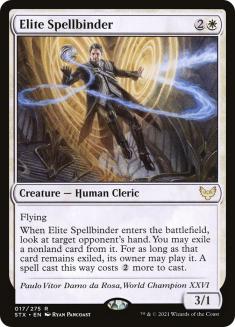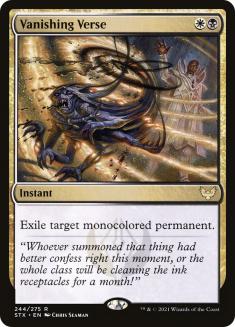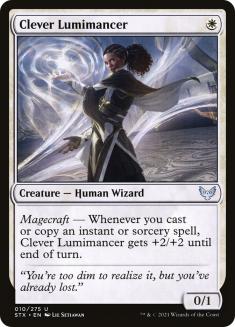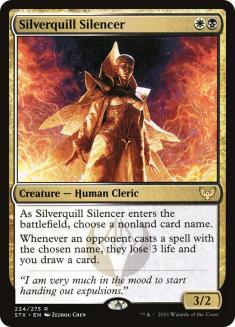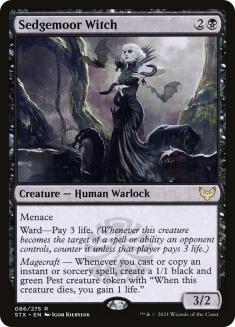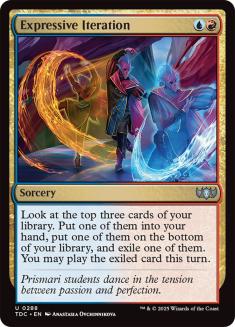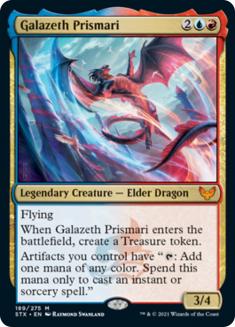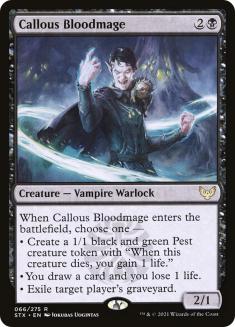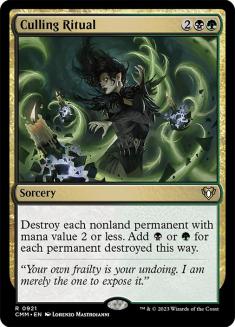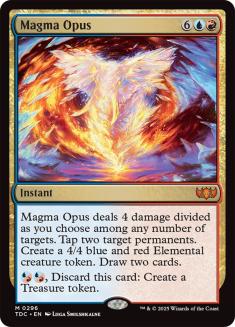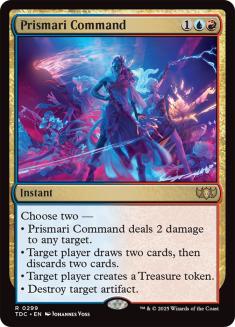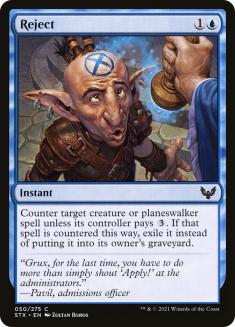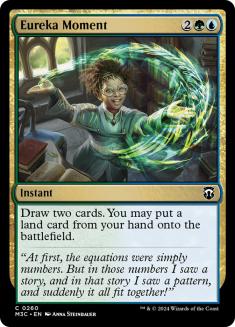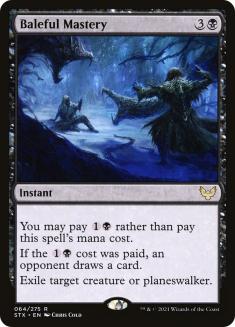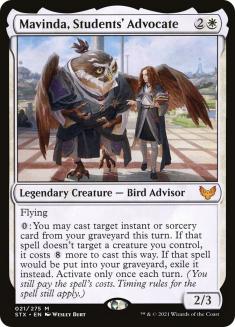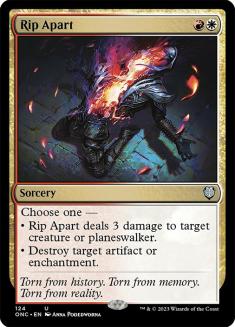Welcome back to Strixhaven First Impressions week!
All week long, various members of the SCG Staff will share their thoughts on the Top 5 Strixhaven cards in each format. On Monday, we praised Vanishing Verse’s impact in Standard and yesterday we waxed poetic about Brainstorm’s introduction to Historic. Today, we’ll knock out Pioneer and tomorrow is Modern.
To add a little fun to the mix, a scoring system has been put in place so that we can get an idea of what card ranked in what place in the aggregate to close out each article. The scoring system is as follows:
- 1st — 5 points
- 2nd — 4 points
- 3rd — 3 points
- 4th — 2 points
- 5th — 1 point
Today we kick things off with Pro Tour Khans of Tarkir champion, Ari Lax!
Ari Lax
- Elite Spellbinder
- Vanishing Verse
- Clever Lumimancer
- Silverquill Silencer
- Sedgemoor Witch
My experience playing Pioneer recently has pointed towards a ton of decks looking to make critical plays on Turn 4 or Turn 5. Elite Spellbinder is flawlessly positioned to break that up, and the Human creature type is extremely relevant, so I have no issues dropping it in the first-place slot.
Vanishing Verse is close though. Pioneer is the first place where you run into Niv-Mizzet Reborn making generic two-colored spells good, and it’s just great removal against anything that isn’t the Niv-Mizzet mirror or Winota, Joiner of Forces.
Patrick Sullivan probably has honorary red one-drop Clever Lumimancer higher on the list. It’s pretty good but I have concerns about its damage output in the lower half of scenarios. I’ve played enough Steppe Lynx to know sometimes you draw a 0/1. Even if spells replace themselves where lands don’t, sometimes you don’t want to take the game actions that maximize Clever Lumimancer because they don’t maximize your other cards. Still, it’s a really good one-drop and it’s hard to complain about that — I’m just arguing for my slightly lower placement.
Silverquill Silencer fits a lot of the same metrics as Elite Spellbinder. It’s just two colors, not a natural Collected Company pairing, and not as sure of a shutoff for the card you want to hit. Still really good stuff.
I originally had Rip Apart in the last slot, but quickly realized it was just a safe and losing bet. Is that card actually better than Abrade’s instant speed? So I’m taking a gamble on one of my favorite cards in the set in Sedgemoor Witch. It layers with a lot of already good cards in Pioneer like Young Pyromancer and Dreadhorde Arcanist, and even as a three-drop it clocks quickly and provides a ton of value against interaction while also being exceptional at catching up from behind.
Todd Anderson
- Vanishing Verse
- Expressive Iteration
- Galazeth Prismari
- Elite Spellbinder
- Callous Bloodmage
In Pioneer, the name of the game when it comes to new cards is incorporating them into existing archetypes. Rarely do we see new cards generate new decks, but you just need to keep your eye out for the unique! My go-to when deckbuilding is to look for a few specific things:
- Creatures with mana value three or less for Collected Company
- Elite-cost interaction
- Ways to gain bursts of resources
- Build-around cards that can pay for themselves
Vanishing Verse fits into the “Elite” category here, costing about one less mana than is expected for the effect. While it has some drawbacks, I think Vanishing Verse will likely be one of the best removal spells in the majority of formats. If you’re playing black and white, you should likely be playing a lot of this card.
Expressive Iteration is one I ‘ve seen a little chatter about. I don’t think it’ll amount to much in Standard, as there doesn’t seem to be a home for Izzet Spells at the moment (though one could certainly be built). In Pioneer, you have multiple ways to build decks around prowess or magecraft, as well as plenty of fodder for triggering those effects. Expressive Iteration is one of the better spells in this vein I’ve seen in a very long time, and here’s why: If you have a land drop to play, it’s almost always going to be a two-mana Divination. In your top three cards, all you need is a land and boom, free extra card. Bonus points if that land can cast one of the spells in your hand!
As the game progresses, Expressive Iteration only gets better. It’s phenomenal and works perfectly alongside Monastery Swiftspear and Soul-Scar Mage to deal a massive amount of damage. All the tools currently exist to play Izzet Prowess. This addition will likely push it into the forefront of the format. At the very least, I could see those red-based aggro decks easily splash for this powerful draw engine. Anyone who’s played Light Up the Stage knows how powerful that type of effect can be in this archetype.
Galazeth Prismari might be incredible. I don’t know for sure, but my gut is telling me that this is “the one” alongside Goldspan Dragon to fuel a constant stream of threats with mana to protect. Galazeth Prismari might also be powerful enough to do something entirely different than what we’re using to seeing in Pioneer. Not only do you get an immediate one mana for free upon resolution, but all your existing artifacts can now tap for mana. There are quite a few good artifacts in Pioneer that could be used to cast a handful of broken instants and sorceries.
No matter how you slice it, Galazeth Prismari is cheap, gives you a rebate, and has the potential to pay for itself on the turn you cast it, assuming things are going your way. Alongside Emry, Lurker of the Loch you could potentially build an artifact shell that wants to use Dig Through Time or Treasure Cruise. My vision is mostly using that mana to protect Galazeth Prismari, but anything is possible when you have a mana engine. Like Urza, High Lord Artificer before it, Galazeth looks cool on paper, but starts to get degenerate when someone finds the right build. We’ll just have to wait and see.
Elite Spellbinder and Callous Bloodmage are both on the list because I think they’re going to be exceptional with Collected Company. So many decks want medium-sized creatures with a lot of text, because hitting a bunch of weird ones with Collected Company means you can mazimize synergy. Elite Spellbinder is a bit better than Callous Bloodmage, but I wouldn’t be surprised to see Abzan Company become a hit playing both. The only downside is that Callous Bloodmage isn’t a Human, which could have been quite strong for an Abzan Humans strategy.
Elite Spellbinder in particular feels like it could be one of the best creatures ever printed. If the play patters happen as I think they will, you’ll likely see Elite Spellbinder in just about every format. Its ability is awesome against a number of archetypes, the body is relatively scary if you’re light on removal, and the ability to blink it over and over gives it some heat when combined with some of white’s other goodies. White might just be making a comeback!
Dom Harvey
- Clever Lumimancer
- Vanishing Verse
- Culling Ritual
- Magma Opus
- Prismari Command
From a Pioneer perspective, Clever Lumimancer is the best student at a struggling local college — an average-sized fish in a small pond. As I discussed in my preview article, Boros Wizards (Lurrus) and Boros Heroic (Lurrus) are natural homes for Lumimancer and, along with Leonin Lightscribe (who deserves at least an honourable mention here), it may spawn new decks in that space.
Vanishing Verse’s restriction is a big deal in a format where most aggro decks have Lurrus, the best midrange deck is literally based around Niv-Mizzet Reborn, and most decks have some crucial threat that dodges it (from Stonecoil Serpent to Mayhem Devil). Nevertheless, this card is versatile enough that it’s a useful addition to Pioneer’s removal roster (especially for those Niv-Mizzet decks).
Culling Ritual’s placement makes a lot of sense in that context — against a Lurrus deck, this sweeps up everything while paying for itself, and that makes it an incredible tool for Bring to Light.
Magma Opus loses one Historic partner in Mizzix’s Mastery, but the interaction with Torrential Gearhulk piques my interest in Pioneer too. It can show off its school pride in an Izzet (Prismari?) Control shell but I could see it in an adaptation of the successful Dimir Control lists — between additional copies giving you Treasure tokens and ‘free’ Pathways, you can cast this card easily in the late-game and the Gearhulk combo lets you finish the game much more quickly in matchups where that matters.
If the Izzet shell does work, I expect Prismari Command to be a big part of it and I can see it boosting other Izzet decks (perhaps revolving around Goldspan Dragon) too.
Shaheen Soorani
- Reject
- Vanishing Verse
- Eureka Moment
- Prismari Command
- Elite Spellbinder
Strixhaven will have a sizable effect on Standard, as all new sets do, but the older formats (outside of Historic) will continue business as usual. This is a clear power drop from previous sets, which is ultimately a good thing. This set has some sideboard implications, with a few gems, that will likely see play in Pioneer.
Reject is in the number-one spot for me from the set, as it will give vital assistance on Turn 2 for control decks that desperately need it. There are the usual suspects there, like Negate and Essence Scatter, but these do not cut it. Reject will handle some problematic creatures that need to be exiled, as well as stretch to hit planeswalkers in a pinch.
My number two represents the essence of wishful thinking. Vanishing Verse is an amazing card that should see extensive play; however, the Orzhov color combination is at a historic level of weakness. If the color combination sees play, in perhaps an Esper Control shell, Vanishing Verse will revolutionize how we see removal.
The rest of the list was tough for me to craft. These three cards have a shot to see play, but I’m not holding my breath. Eureka Moment is a strong card in a vacuum, but it has some steep competition. Simic-based ramp/control decks are running around the format and I hope they see the strength in this card as I do.
Prismari Command and Elite Spellbinder are the most Pioneer-level cards that can shine if the supporting archetypes rise to the occasion. There are some Izzet decks that pop up here and there, as well as Mono-White Aggro variations. Both existing archetypes could embed these, but it remains to be seen if Pioneer is too ahead of the power curve to make use of them.
Reject and Vanishing Verse will be in the next Pioneer deck from me, even if I cannot guarantee their ultimate success.
Ross Merriam
- Elite Spellbinder
- Vanishing Verse
- Baleful Mastery
- Mavinda, Students’ Advocate
- Rip Apart
Oof. Normally the tough part of these lists is narrowing the list down to just five. With Strixhaven, it’s tough to even find that many. I don’t see any cards reshaping the format to the degree we’ve seen with cards in the last two years, but there are several solid role-players here.
Elite Spellbinder takes my top spot because of how well it plays with Collected Company, and the fact that there aren’t as many cheap removal spells that risk you losing tempo with a one-toughness creature for three mana. This is a powerful effect for any disruptive aggressive deck, so while there isn’t an obvious home, I could see it elevating a new archetype to the realm of viability.
I’m going to skip down to fourth to cover the other creature on the list, Mavinda, Students’ Advocate. Unlike Elite Spellbinder, Mavinda does have an obvious home in Boros Heroic. The synergy is clear, and the only issue is how it clashes on the curve with Feather, the Redeemed. Feather is the more powerful card, but Mavinda is much easier on the mana, and given that they’re both legendary, I could easily see a split being optimal.
The remainder of the list consists of various good removal spells. Vanishing Verse leads the way because of its versatility. It answers most of the primary threats in the format, although it’s clearly weak against Niv-Mizzet Reborn decks. Baleful Mastery takes third because of its potential synergy with Narset, Parter of Veils. The four mana mode isn’t that much worse than Hero’s Downfall, especially if the exile clause of Mastery is relevant, and there will be times where giving your opponent a card is worth the discount so you can get to the late-game. But getting the best of both worlds is the kind of upside that excites me.
Last on the list is Rip Apart, another versatile removal spell, but this one gets downgraded because it’s a sorcery. I view Rip Apart is a great sideboard card, since it will likely save you space by covering a number of bases at once. That’s certainly valuable, but it’s not going to dominate any games. In most sets, that wouldn’t get a mention, but here it’s enough to sneak into the Top 5.
And now, without further ado, the SCG Staff’s Top 5 Strixhaven cards for Pioneer are…
T-5. Galazeth Prismari, Culling Ritual, Prismari Command — 3 points
4. Reject — 5 points
3. Clever Lumimancer — 8 points
2. Elite Spellbinder — 13 points
1. Vanishing Verse — 20 points
Cya back here tomorrow for our thoughts on Strixhaven’s impact on Modern!


